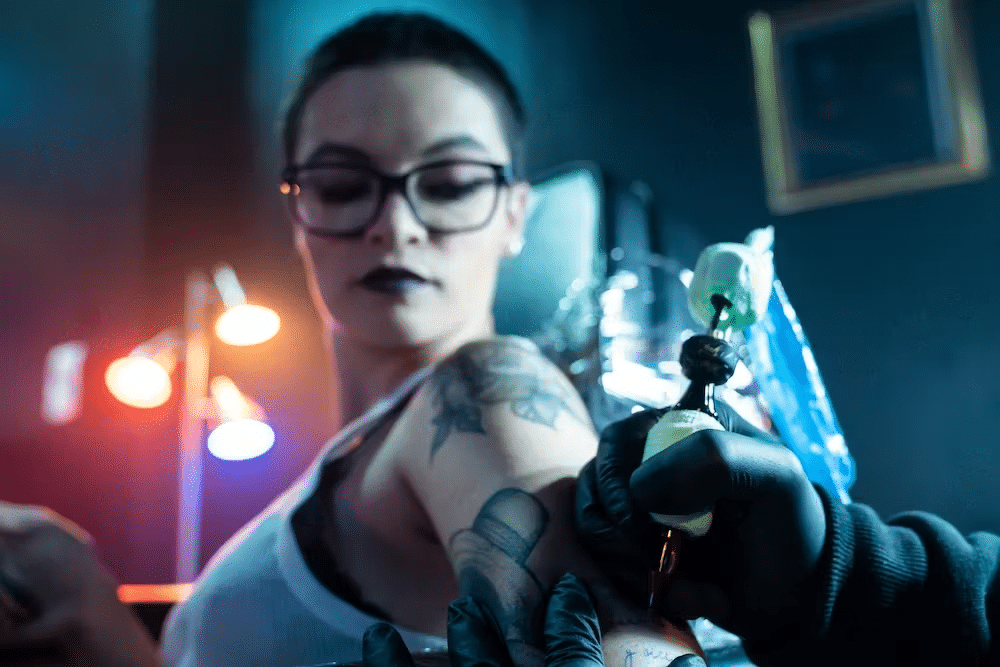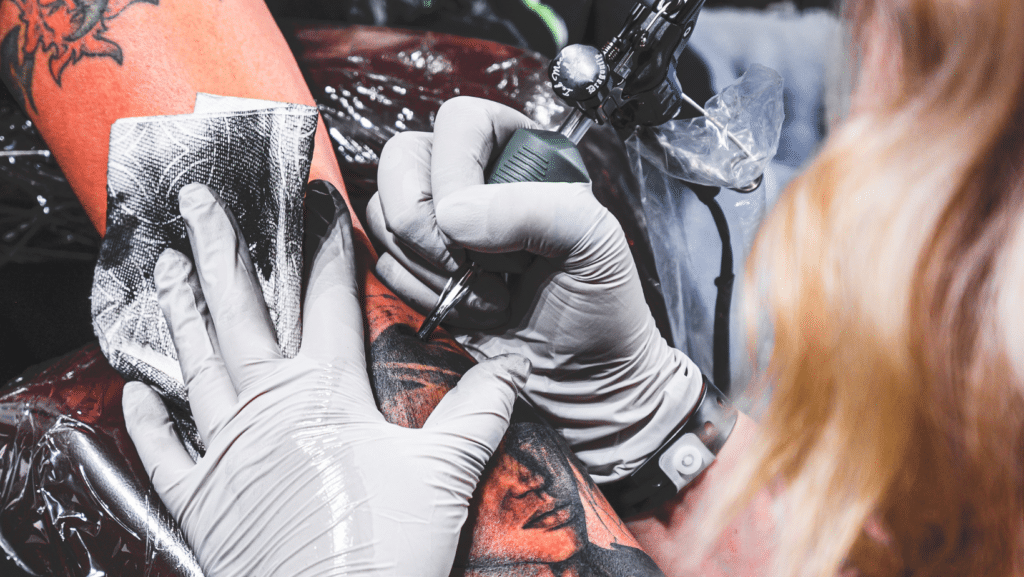The Importance of Tattoo Aftercare in the UK
When it comes to tattoos, the journey doesn’t just end with the ink hitting the skin. Proper aftercare is essential for ensuring your tattoo heals beautifully and retains its vibrancy for years to come. This is particularly crucial in the UK, where our unique climate poses specific challenges to tattoo healing.
According to recent statistics from the British Tattoo Artists Federation, the tattoo industry in the UK is thriving, with over 1,500 registered tattoo studios spread across the country. With such a burgeoning industry, understanding the dos and don’ts of tattoo aftercare tailored to our British environment becomes paramount. Let’s delve into the top 10 tips for healing your tattoo in the UK.

1. Keep it Clean and Moisturized:
Proper Cleaning Techniques:
Proper cleaning techniques using mild soap and water are essential for maintaining the hygiene of your healing tattoo. Opt for fragrance-free, gentle cleansers to prevent irritation. Ensure to pat the tattoo dry gently with a clean towel, avoiding rubbing or harsh motions that could damage the sensitive skin.
Regular Moisturising:
Moisturising your tattoo regularly helps to keep the skin hydrated, promoting faster healing and preventing excessive scabbing. Selecting the right moisturiser is crucial; opt for fragrance-free, hypoallergenic options to minimise the risk of irritation. Apply a thin layer of moisturiser to the tattooed area, ensuring complete coverage without suffocating the skin.
Avoid Over-Moisturizing:
Avoid over-moisturizing, as excessive moisture can lead to problems such as prolonged healing times or even infection. Stick to the recommended frequency of moisturising provided by your tattoo artist or dermatologist. By keeping your tattoo clean and properly moisturised, you’ll support its healing process and ensure optimal long-term results.
2. Avoid Direct Sunlight:
Protecting Your Tattoo:
The importance of protecting your tattoo from harmful UV rays cannot be overstated. Direct sunlight can cause fading and damage to your tattoo, compromising its appearance over time. Optimal sunblock choices suitable for UK weather conditions include those with high SPF and broad-spectrum protection.
Seek Shade:
During peak sunlight hours, it’s advisable to seek shade whenever possible to minimise exposure to UV radiation. This is especially crucial in the summer months when the sun’s rays are strongest. Carrying a hat or wearing clothing that covers your tattooed area can provide additional protection against sun exposure.
Mindful Sunbathing:
If you enjoy sunbathing or spending time outdoors, take extra precautions to shield your tattoo from direct sunlight. Apply a generous amount of sunscreen to your tattooed skin, reapplying as directed to maintain protection throughout the day. By avoiding direct sunlight and taking proactive measures to protect your tattoo, you can preserve its vibrancy and longevity.
3. Say No to Scratching:
Understanding the Risks:
Scratching a healing tattoo can disrupt the delicate healing process and lead to complications such as scarring and infection. It’s essential to resist the urge to scratch, even if the tattoo feels itchy or irritated. Scratching can also cause the ink to become patchy or uneven, affecting the final appearance of your tattoo.
Gentle Alternatives:
Instead of scratching, try gently tapping or applying moisturiser to alleviate itching and discomfort. Using clean hands, lightly tap or pat the tattooed area to soothe irritation without causing damage. Applying a thin layer of moisturiser can also help to hydrate the skin and reduce itching.
Distraction Techniques:
If you find yourself tempted to scratch, distract yourself with other activities to take your mind off the discomfort. Engage in hobbies, listen to music, or spend time with friends to divert your attention away from the urge to scratch. By avoiding scratching and implementing gentle alternatives, you can support the healing process of your tattoo and achieve optimal results.
4. Clothing Matters:
Choose Breathable Fabrics:
Selecting the right clothing is crucial for preventing irritation and promoting healing. Opt for loose-fitting, breathable fabrics such as cotton to allow your skin to breathe. Avoid tight or restrictive clothing that can rub against your tattoo and cause discomfort or damage.
Avoid Rough Fabrics:
Rough fabrics like wool or synthetic materials can exacerbate irritation and friction on healing tattoos. Opt for softer, smoother fabrics that are gentle on the skin and won’t cause unnecessary rubbing. Pay attention to the texture of your clothing and choose items that are comfortable and non-abrasive.
Consider Weather Conditions:
In the UK, weather conditions can vary dramatically, so it’s essential to dress accordingly to protect your healing tattoo. Layering clothing can help you adjust to changing temperatures while ensuring your tattoo remains covered and shielded from the elements. By choosing the right clothing and considering weather conditions, you can promote healing and prevent discomfort for your tattoo.
5. Don’t Soak in Water:
Risks of Soaking:
Soaking in water, whether it’s in a bathtub, pool, or hot tub, can pose risks to a healing tattoo. Prolonged exposure to water can soften the skin and cause the tattoo to become waterlogged, potentially leading to ink loss or blurred lines. Additionally, soaking can increase the risk of infection by exposing the healing tattoo to bacteria and other contaminants.
Showering Tips:
When showering, it’s essential to take precautions to protect your healing tattoo. Avoid direct water pressure on the tattooed area and keep showers short to minimise exposure to water. Use lukewarm water and gentle, fragrance-free soap to clean the tattoo, being careful not to scrub or rub the area.
Bathing Alternatives:
Instead of soaking in a bathtub, consider taking showers as an alternative bathing method during the healing process. Showers allow you to clean your body while minimising direct contact with water on the tattooed area. If you prefer baths, keep them short and shallow, and avoid submerging your tattoo entirely.
By avoiding prolonged soaking in water and following proper showering techniques, you can protect your healing tattoo and promote optimal healing.

6. Mindful Exercise:
Choosing Low-Impact Activities:
During the healing process, it’s crucial to choose low-impact exercises that won’t put undue strain on your healing tattoo. Avoid activities that involve a lot of friction or movement in the tattooed area, as this can cause irritation and slow down the healing process. Opt for gentler forms of exercise such as walking, yoga, or light stretching to stay active without risking damage to your tattoo.
Protecting Your Tattoo:
When engaging in physical activity, take steps to protect your healing tattoo from sweat, friction, and other potential irritants. Wear loose-fitting clothing that won’t rub against the tattooed area, and consider covering the tattoo with a breathable bandage or protective wrap if necessary. Be mindful of your body’s movements and avoid any activities that cause discomfort or pain around the tattoo.
Post-Exercise Care:
After exercising, take the time to clean and moisturise your tattoo to keep it healthy and promote healing. Use gentle soap and water to wash away sweat and bacteria, and pat the tattoo dry with a clean towel. Apply a thin layer of fragrance-free moisturiser to keep the skin hydrated and prevent excessive drying or scabbing. By taking a mindful approach to exercise and prioritising proper care for your healing tattoo, you can support its recovery and ensure optimal results.
7. Skip Swimming Sessions:
Risks of Swimming:
Swimming in pools, lakes, or the sea poses significant risks to a healing tattoo. Water in these environments contains bacteria and other contaminants that can infect the healing skin, leading to complications such as inflammation and delayed healing. Additionally, prolonged exposure to water can cause the tattoo to become waterlogged, leading to ink loss or distortion of the design.
Alternative Recreational Activities:
Instead of swimming, consider alternative recreational activities that won’t jeopardise the healing process of your tattoo. Activities such as hiking, cycling, or exploring the city can provide enjoyable alternatives while minimising the risk of exposure to water. Be sure to choose activities that won’t cause excessive sweating or friction on the tattooed area.
Waiting for Full Healing:
It’s essential to wait until your tattoo is fully healed before resuming swimming activities. The healing process typically takes several weeks, during which time the tattooed skin is vulnerable to damage and infection. Listen to your tattoo artist’s aftercare instructions and avoid swimming until you receive the all-clear from them. By prioritising the health and integrity of your tattoo, you can ensure it heals properly and maintains its appearance for years to come.
8. Avoid Picking Scabs:
Role of Scabs in Healing:
Scabs play a crucial role in the tattoo healing process by protecting the underlying skin and promoting tissue regeneration. They form as a natural response to the skin trauma caused by tattooing and help seal the wound to prevent infection. Picking or removing scabs prematurely can disrupt this process and lead to complications such as scarring or pigment loss.
Risks of Picking:
Picking or peeling scabs can cause damage to the newly formed skin underneath, delaying the healing process and increasing the risk of infection. It can also result in uneven healing and affect the final appearance of your tattoo. Additionally, picking scabs can be painful and may lead to further irritation and inflammation of the skin.
Gentle Care:
Instead of picking scabs, practise gentle care techniques to support the natural healing process of your tattoo. Keep the tattooed area clean and moisturised to prevent excessive dryness and itching, which can contribute to the temptation to pick. If you experience discomfort or itching, try tapping or applying a cold compress to soothe the skin without disrupting the scabs. By allowing the scabs to heal naturally, you can ensure optimal results and preserve the integrity of your tattoo.

9. Keep Pets Away:
Contamination Risks:
Pets, while beloved companions, can pose contamination risks to a healing tattoo due to their fur, saliva, and natural skin bacteria. Contact with pet hair or saliva can introduce bacteria to the tattooed skin, increasing the risk of infection and complications. It’s crucial to keep pets away from the healing tattoo to minimise the risk of contamination.
Creating a Pet-Free Zone:
During the initial healing stages, create a designated pet-free zone to protect your tattoo from potential exposure to pet-related contaminants. This may involve restricting your pet’s access to certain areas of the house or keeping them out of the room where you spend the most time. By creating a pet-free zone, you can reduce the risk of bacterial transfer and support the healing process of your tattoo.
Hand Hygiene:
If you do need to interact with your pet, practise good hand hygiene before and after handling them. Wash your hands thoroughly with soap and water to remove any pet-related contaminants before touching your healing tattoo. This simple precaution can help prevent the introduction of bacteria and promote optimal healing for your tattoo.
10. Follow Professional Advice:
Importance of Listening:
One of the most crucial aspects of tattoo aftercare is following the professional advice provided by your tattoo artist. They have extensive experience and knowledge in tattoo healing and can offer personalised guidance tailored to your specific tattoo and skin type. It’s essential to listen carefully to their instructions and follow them diligently to ensure the best possible outcome for your tattoo.
Seeking Help if Needed:
If you have any concerns or notice signs of infection during the healing process, don’t hesitate to seek professional help. Your tattoo artist or a dermatologist can provide expert advice and treatment to address any issues and prevent further complications. Ignoring problems or attempting to self-diagnose can lead to more significant problems down the line, so it’s essential to seek help promptly if needed.
Trusting Reputable Studios:
When it comes to tattoo aftercare, it’s crucial to trust reputable UK-based tattoo studios like Pearl Lemon Tattoos. They adhere to strict hygiene standards and provide comprehensive aftercare instructions to ensure the health and longevity of your tattoo. By following their advice and trusting their expertise, you can enjoy a beautiful, well-healed tattoo for years to come.
Ensuring Your Tattoo’s Longevity in the UK
Healing your tattoo in the UK requires careful attention and adherence to specific guidelines tailored to our unique climate. By following the top 10 do’s and don’ts outlined in this guide, you can ensure that your tattoo heals beautifully and maintains its vibrancy for years to come. From keeping it clean and moisturised to avoiding direct sunlight and picking scabs, each step plays a crucial role in supporting the healing process and preserving the integrity of your tattoo.
Remember to listen to the advice of your tattoo artist and seek professional help if needed, especially if you notice any signs of infection or complications. By trusting reputable UK-based tattoo studios like Pearl Lemon Tattoos, you can ensure that you receive expert guidance and support throughout the healing journey.
Trust Pearl Lemon Tattoos for Expert Tattoo Services
For expert tattoo services and aftercare guidance, trust Pearl Lemon Tattoos, a leading name in the UK tattoo industry. Visit our studio or contact us today to schedule your appointment and discover why we’re the preferred choice for tattoo enthusiasts across the UK. Let us help you bring your tattoo vision to life and ensure that it heals flawlessly for a lifetime of enjoyment.




